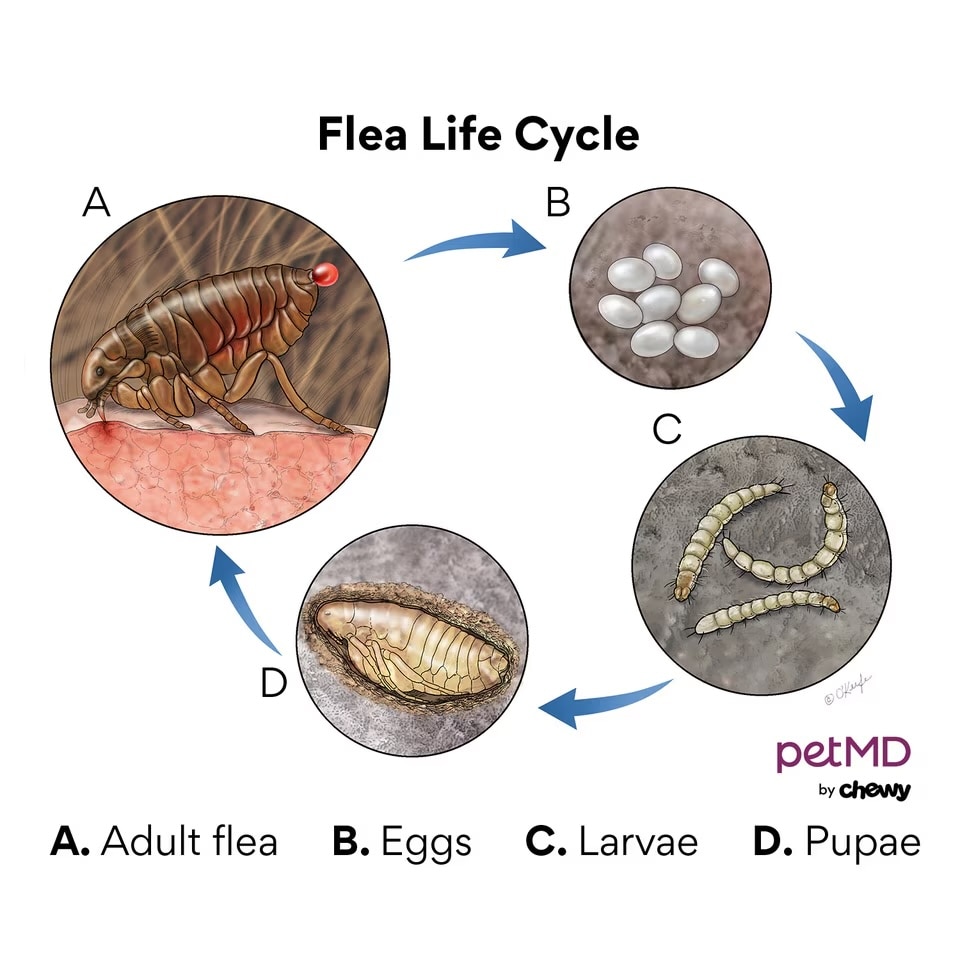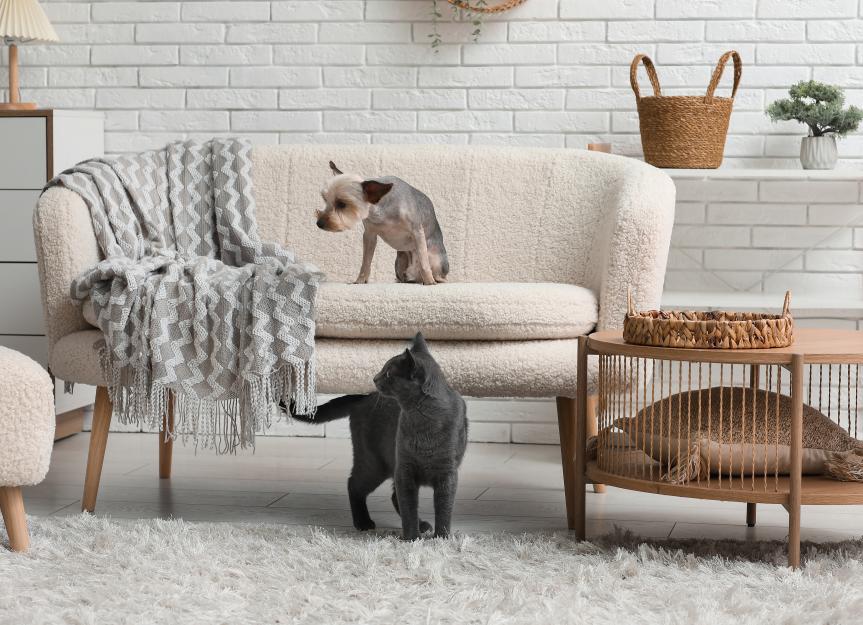If you are dealing with a flea infestation, you know how challenging it can be, both for you and your pet.
Fleas multiply quickly, causing itching and discomfort. They can also carry diseases. Even if your pet stays indoors, or you don’t have pets at all, fleas could still end up in your home by hitching rides on people and objects.
Completely getting rid of a flea infestation may take time, due to the flea’s life cycle, but there are steps you can take to provide immediate relief.
With the right approach and patience, you can get the situation under control and prevent fleas from coming back.
Key Takeaways
- Signs of a flea infestation include itchiness, flea dirt, and, of course, spotting adult fleas on you, your pet, or in the environment.
- Fleas can pose health risks, including tapeworms, cat scratch disease, and anemia in vulnerable pets.
- Flea infestations can drag on for weeks to months due to the flea lifecycle.
- Complete elimination of a flea infestation requires consistent treating of pets and the environment.
What Are Fleas?
Fleas are small, wingless parasites that feed on the blood of pets, humans, and other animals several times a day.
Measuring about an eighth of an inch in length or a little shorter, fleas can jump as far as 19 inches—that’s more than 150 times their body length. To make matters worse, a single female can lay roughly 50 eggs in a single day. Can you see how an infestation can happen quickly?
Fleas have a four-stage life cycle:
A. Adult
B. Egg
C. Larva
D. Pupa

Adult fleas lay eggs on their host, which can fall off and hatch in the environment. Flea life cycles can be as quick as two to three weeks or can be longer, because flea pupae can lay dormant for extended periods of time (in which case it could take months to get a severe flea infestation under control).
Fleas are more than just irritating. They can transmit diseases and parasites to people and their pets.
For instance, tapeworms in cats and dogs are spread by fleas. Fleas also carry Bartonella bacteria, the culprit behind cat scratch disease in cats and humans. In severe cases, flea infestations can cause anemia in kittens and puppies.
How To Detect Fleas on Your Pet
Fleas will bite and feed anywhere on pets, but the most common spots they bite are at the base of the tail and along the back.
Signs a pet has fleas include:
- Itching
- Gnawing and biting
- Flea dirt (flea waste that looks like tiny, black, pepper-like specks)
- Hair loss
- Irritated or scabbing skin
- Visible fleas
How To Detect Fleas in Your Home
Fleas are more common in homes with pets, but it doesn’t take having a pet to develop a flea infestation.
Fleas could be lying dormant in your new apartment or hitch a ride from the outdoors into your home. Wildlife in your backyard like squirrels, raccoons, and feral cats can also carry fleas that can eventually make their way inside.
You’ll likely see a few adult fleas at first or their bites. Flea eggs, larvae, and pupae, on the other hand, are easy to miss.
- Signs that your home has a flea infestation include:
- Bites, particularly around the ankle
- Spotting small, round flea eggs in carpet, furniture, and blankets
- Flea dirt on bedding, floors, and socks
- Visible fleas
The most common places to find fleas, their eggs, and waste in the home include:
- Bedding
- Blankets
- Rugs
- Carpeting
- Upholstery
- Pet beds
- Cracks and gaps in flooring
- Behind baseboards and molding
White Sock Test
A simple way to check if your house has fleas is to put on white socks and walk around the house. Adult fleas are attracted to movement and warmth, so they will jump onto the socks.
While fleas on your socks might be the last thing you want, it’s a quick way to spot them due to the contrasting color.
Flea Dirt vs. Dirt
At a glance, flea dirt looks a lot like regular dirt, because it is small and dark in color. However, flea dirt is not dirt at all. It’s actually flea feces, which contains digested blood, and it turns reddish-brown when damp.
To tell the difference between flea dirt and actual dirt, grab a damp paper towel and put some flecks on it. If it turns reddish-brown, it’s flea dirt.
How To Get Rid of Fleas on Your Pet
To get rid of fleas quickly, use a fast-acting flea treatment like Capstar, which starts killing adult fleas within 30 minutes. Available without a prescription, the oral tablet lasts 24 hours and is safe for daily use. Capstar is available in both dog and cat formulas.
Bathing your pet with a flea shampoo (being sure to use a cat shampoo for cats and a dog shampoo for dogs) and using a flea comb also can help remove adult fleas quickly.
Though all of these options can provide immediate relief, you’ll want to put your pet on a vet-recommended flea preventive for dogs or cats to provide long-term protection.
Flea preventives are available over the counter (OTC) and by a prescription from your vet. They come in different forms, including oral medications, topical solutions, and flea collars. Some may also protect against internal parasites, like tapeworms, hookworms, roundworms, and heartworms.
Whatever flea treatment you use, make sure it is formulated for your pet’s species, age, and weight. Your veterinarian can help you determine the best flea treatment for your individual pet.
How To Get Rid of Fleas in Your Home
Treating your pet is only part of the solution. To get rid of a flea infestation, you have to treat the home and yard, too, because adult fleas and especially their eggs can live in the environment.
Here’s how to get rid of a flea infestation in your home and yard.
In Your Bed
- Wash all bedding (sheets, pillowcases, blankets) in hot, soapy water.
- Dry the bedding on high heat.
- Vacuum the mattress and surrounding areas thoroughly.
On Your Furniture
- Vacuum upholstery thoroughly.
- Use flea sprays designed for furniture that are safe for use around the types of pets in your home.
- Wash removable covers and cushions in hot soapy water. Dry on high heat (if washing instructions allow).
- Steam-clean furniture that cannot be washed.
In Your Carpet and Rugs
- Vacuum carpets and rugs at least twice a day, disposing of the vacuum bag or canister contents immediately.
- While optional, steam cleaning after vacuuming can kill fleas and eggs lodged in carpet fibers.
- Apply flea sprays or powders designed for carpets. The product should be safe for use around the types of pets in your home. Make sure the treatment penetrates deep into the carpet fibers.
In Your Yard
- Maintain your yard by mowing regularly, removing leaf litter and debris, and trimming overgrown plants.
- Reduce shaded areas and avoid overwatering your plants.
- Apply beneficial nematodes. They’re microscopic worms that will live in your soil, preying on pests like fleas, aphids, and caterpillars. They don’t pose risks to humans or pets.
- Apply pet-safe insecticides designed for outdoor areas.
When To Call the Professionals
For stubborn flea infestations that aren’t resolved with home cleaning methods, consider professional pest control. The cost depends on the infestation’s severity, and treatments typically take a few weeks spread over several visits.
How To Prevent a Flea Infestation
The key to preventing fleas on pets and in the home is by keeping all pets in the household up to date on flea preventives.
Warmer winters have led to fleas being a year-round problem, not just seasonal. It’s one of the reasons veterinarians recommend year-round coverage for fleas, ticks, and intestinal parasites.
Routine cleaning, sanitizing new furniture and clothing, and regular yard maintenance can prevent infestations in homes with or without pets.
How To Get Rid of Fleas FAQ
How do you get rid of fleas in the house quickly?
To get rid of fleas in the house quickly, treat your pets with a fast-acting tablet like Capstar or a flea bath to kill adult fleas, then provide a long-term flea preventive.
Vacuum daily, wash bedding in hot water, and use flea sprays or powders on carpets, furniture, and the yard. Repeat consistently for several weeks to break the flea life cycle.
What kills fleas the fastest?
The fastest way to kill fleas on pets is with an oral tablet like Capstar, which starts working within 30 minutes and kills most adult fleas in 4–6 hours. For lasting control, follow up with a monthly flea preventive.
How long does a flea infestation last in your house?
A flea infestation in your house can last several weeks to a few months, depending on how established it is and how consistently you treat it. Because fleas hatch in cycles, adult fleas may keep appearing. Persistent cleaning, pet flea treatments, and environmental control are needed to fully eliminate them.



